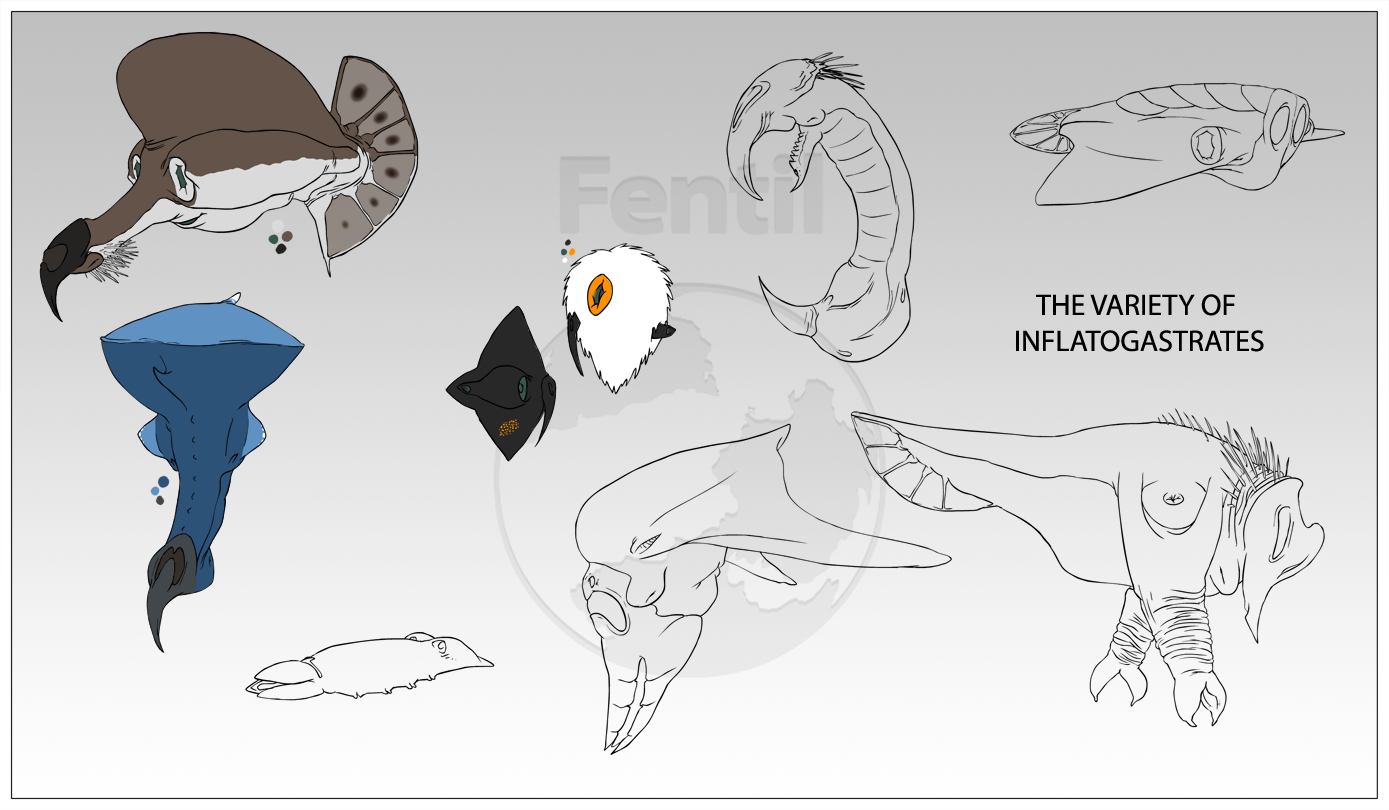Now go look at 1:21, I was pretty excited to see it in the trailer.
Look again, it's a pretty quick shot.
Look familiar?


That's right. They decided to include a quick bit of footage of Meat Cello, that move I designed for the competition.
It looks great, they've done a great job with it. It looks so much better in 3D. Although I've only seen this small clip, I've been told that the whole move is in the game and "looks just like the original flash animation".
I'm really looking forward to seeing and using that move in the finished game.
Moving on from Dead Space; I've been busy on this little Fentil-related piece:

It's a spread of the different types of inflatogastrates
(clockwise from left)
Finworm (Rock-stalker)
The 'typical' inflatogastrate. They vary greatly in size and shape, and spend most of their time high in the air, silently scanning for prey, while also looking out for larger, equally cunning airborne predators.
An example of these is the Arctic finworm , which, unlike other finworms, hunts more like a land-based predator; The thin, cold air stops it from getting enough buoyancy to float higher, so it stalks its prey by taking cover behind mounds and snow banks.
Micromorphs (Diamond darter & Puff owl)
The smallest (by average) of all airborne inflatogastrates. Because of their size, micromorph species often haunt in swarms - safety in numbers.
Diamond darters live only on the small, isolated island, Subi. Subi is unique to Fentil as it near-constantly has a thick, humid and highly acidic atmosphere, which is retained by the dense forests. Puff owls are only found on the large southern continent.
Gripworm (Leatherbelly)
While having airborne ancestors, gripworms lost their inflatable bladders soon after getting them and live a more snake-like, arboreal lifestyle. The back-looping gut system of modern inflatogastrates is modified, resulting in a creature that is almost all neck and uses its vent as a opposable digit (inflatogastrate vents are usually gill-like structures at the base of the neck which constantly drip waste). This digit allows them to easily grab and swing from branches. It also aids in trapping prey.
Burner (Firebird)
Burners The linked sheet explains most of the details about burners.
Hover Prowler (Vinestalker)
Another inflatogastrate group that has returned to the ground.
Hover prowlers' siphons no longer function to propel them through the air. Instead, they use the leg-like tips to pull their buoyant body along, making them perfectly silent predators. The terminal half of their 'limb' is stretchy and can retract and move about in a similar way to an elephant's trunk. The pads at the end are similar in function to chameleon feet.
Mandibulopd (Spear dropper)
The most intelligent of inflatogastrates. Their cognitive skill is similar to that of birds such as Kea. They can use their three legs to manipulate objects, such as burner larvae (spears)
Similar to hover prowlers, the powerful siphons used by other inflatogastrates are re-worked; the olfactory nodes are substantially larger and the siphons relatively smaller. They use wing-like projections of the siphons to propel through the air, flapping them in a bird-like manner.
Despite being vicious predators, their intelligence leads many species to also be very inquisitive and neophilic.
Screamer (Striped creeper)
A 'living fossil' species. Screamers are perfect examples of what ancient inflatogastrates looked like - 3 unfused mandibles, segmented body, straight gut, 3 posterior spiracle pouches, and fleshy lobopod-like legs.
As the gas bag became more prominent in inflatogastrate lifestyle, the body curved around underneath, leading to a U-turn gut and one of the spiracle pouches ending up on the bottom of the body, with the other two becoming the powerful siphons.
Screamers get their name from the surprisingly loud calls that they use to communicate.
Dangler (Pseudo pulmonary)
Possibly the next most primitive group after screamers. They are ground-based predators which simply hang from their gas bag, all 3 undifferentiated spiracle pouches aligned radially around the body.
Most danglers are ambush predators, using camouflage to remain hidden. Many mimic Pulmonary plants due to the similar tri-lateral symmetry and simple shape.
It's going to be a big picture and I'm doing this in the same way I did this piece:

I did the lines in Flash, then went into Photoshop to colour it. I really like this way of doing things, as I have trouble keeping definite edges when painting in Photoshop. Also, it's nice having some lines to colour inside, I find it easier to define the form and just be more detailed in general without having to worry about the niggly little edges.
This is what the inflatogastrate thing looks like without using lines at all, just going straight from sketches:

It just looks messy. Also, that small one above took about twice as long as the line one did.
I do want to get much better at doing realistic things in Photoshop, though. Perhaps next time I'll use thinner lines and slowly get rid of them.
That's all for now.
No comments:
Post a Comment